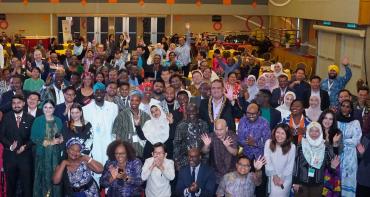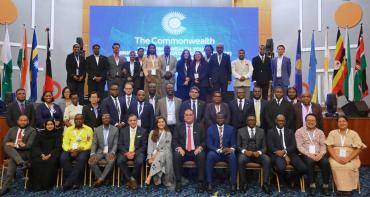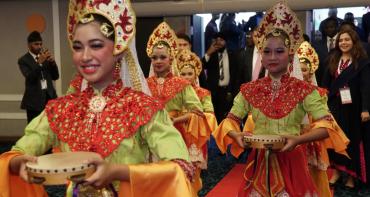To mark International Youth Day 2016, on 12 August, the first-ever Australian National Youth Development Index report has been launched with support from the Commonwealth Secretariat.

To mark International Youth Day 2016, on 12 August, the first-ever Australian National Youth Development Index report has been launched with support from the Commonwealth Secretariat.
The index measures the situation for 6.3 million young people aged 10 to 29 in Australia, and examines changes between 2006 and 2015 across five domains: education, health and well-being, employment, civic participation and political participation.
According to the index, all Australian federal states and territories have seen an improvement in overall youth development since 2006, with the one exception of Tasmania. Political participation has seen the largest improvements nationwide, with increases in the numbers of young people taking part in democratic processes.
Overall national youth health and wellbeing has however deteriorated, with illicit drug use, mental health, suicides and growing rates of sexually transmitted diseases key drivers of this decline.
The report highlights a large developmental gap between urban and rural areas, with the percentage of young people not engaged in education, employment or training significantly higher for rural youths than for urban youths. In addition, the index registered a large developmental gap for young people with Indigenous heritage, who experience much higher suicide rates than for non-Indigenous young people.
The Australian National Youth Development was commissioned by the Commonwealth Secretariat, with the input of youth experts from the Institute for Economics and Peace, the University of Canberra, the Australian Bureau of Statistics, the Australian Institute for Health and Welfare, the University of Victoria and Youth Action.
The index complements the global Youth Development Index (YDI), an initiative of the Commonwealth Secretariat’s Youth Programme that measures the status of young people in 185 countries. Australia came top in the 2013 index.
Ms Katie Acheson, the chief executive of Youth Action, an Australian NGO focused on youth development, described the new index as a “milestone” achievement. “The YDI is the first ever national holistic framework to measure youth development in Australia. This is important because it shows us where we have been, where we are now, and where we can go.
“But this first report is just the start - a demonstration of the power and knowledge we can have if we continue to own and grow this index. So while we have this moment in time, we must solidify the next steps for this important measure for Australian young people and the people who support them,” she said.
The index will be formally launched at a ceremony in Canberra on 12 August attended by senior officials in the Australian government, youth workers, young people, as well as youth sector stakeholders and development practitioners from across the country.
Commonwealth Deputy Secretary-General Deodat Maharaj expressed delight that Australia’s national index is being launched on International Youth Day, a moment when the focus of the international community is focused on youth empowerment.
Mr Maharaj stated: “When the YDI was first launched , we hoped that it would inspire a global debate on the importance of gathering youth-specific data. I commend those involved in this project for their commitment to advancing youth empowerment throughout Australia and the wider Commonwealth. The Commonwealth Secretariat stands ready to assist any other countries that seek to follow Australia’s example.”
The second edition of the Commonwealth Secretariat’s global Youth Development Index will be launched in late September 2016.
Key findings
Rural-Urban Divide
- Stark divisions in education and employment opportunities between youth living in rural and urban areas, as well as for health and wellbeing.
- Rate of rural young people aged 15 to 29 who are not in employment, education or training higher than urban youth in all states and territories.
- Rural youth more likely to be victims of assault than those in urban areas across all states and territories, except Tasmania.
Aboriginal and Torres Strait Islanders
- Suicide rates for indigenous males aged 25 to 29 are higher than national rate.
- Rate of victimisation of indigenous youth much higher, with 31% of 18 to 24 year-old Indigenous youths a victim of physical or threatened violence in the previous 12 months.
Northern Territory
- Ranked lowest across the index.
- Second highest for civic participation, with the highest proportion of young people who undertake volunteer work.
- Only state or territory to have made gains in health and wellbeing, with a 47% decrease in assault rates and a 21% decrease in suicide
- Highest rate of young people not in employment, education or training.
- Highest rate of chlamydia infections.
- Highest rate of illicit drug use, with nearly half of all youth using illicit drugs in previous 12 months.
- Highest adolescent birth rate in the nation.
- Lowest literacy and numeracy rates with little improvement over past decade.
Tasmania
- Ranked second last in the index and the only state or territory whose overall score deteriorated from 2006.
- Largest drop in health and wellbeing of all states and territories.
- 127% increase in the proportion of youth who have recently used illicit drugs.
- 62% increase in the rate of chlamydial infections.
- Highest proportion of 29 year olds whose highest level of education is year 10 or below.
- Second highest adolescent birth rate in the nation.
- Highest rate of assault, with 11% of 15 to 29-year-olds victims of assault in the previous year.
- Highest youth suicide rate in the nation.
Australian Capital Territory
- The top performer in the index.
- Highest scores of all states and territories in all areas except health and wellbeing, where it came second to NSW.
- A 35% deterioration in health and wellbeing was driven by increases in chlamydial infections and the use of illicit drugs.
- Highest percentage of year 9 students meeting national literacy standards.
- Ratio of youth unemployment to total unemployment worst in nation.
South Australia
- The largest decline in its education score during the previous decade.
- Increase in proportion of year 9 students absent for NAPLAN literacy and numeracy tests.
- Second highest rate of assault, with 10% of 15 to 29 year olds experiencing assault in previous year.
Western Australia
- 16% increase in its overall index score since 2006.
- Second highest improvement to education results.
- Third highest rate of assault, with 9% of 15 to 29 year olds experiencing assault in previous year.
- Second highest rate of chlamydia infections.
- Third highest youth suicide rate.
Queensland
- 56% increase in the rates of chlamydial infection.
- 72% increase in recent use of illicit drugs.
- 8% increase in suicide rates, with second highest suicide rate in the nation.
- Second highest rate of young people aged 15 to 29 who are not in employment, education or training.
- Third highest adolescent birth rate.
Victoria
- The most dramatic increase in political participation.
- Health and wellbeing only area to see a decline, driven by increases in chlamydial infections and the use of illicit drugs.
- Second highest rate of illicit drug use, with 38% of young people using drugs in the previous year.
New South Wales
- Ranked second overall.
- 37% decrease in the numbers of youth not in employment, education and training since 2006.
- 18% decrease in the adolescent birth rate.
- Slight decrease in education, with decline in the percentage of year 9 students meeting minimum national standards for literacy.
- Decrease in health and wellbeing.
- 62% increase in chlamydia infections since 2006.
Youth Action Media Contact
Tim Vollmer
Tel: +61 404 273 313
www.youthaction.org.au
Media Contact:
Will Henley
Senior Communications Officer
Commonwealth Secretariat
Email: [email protected]



